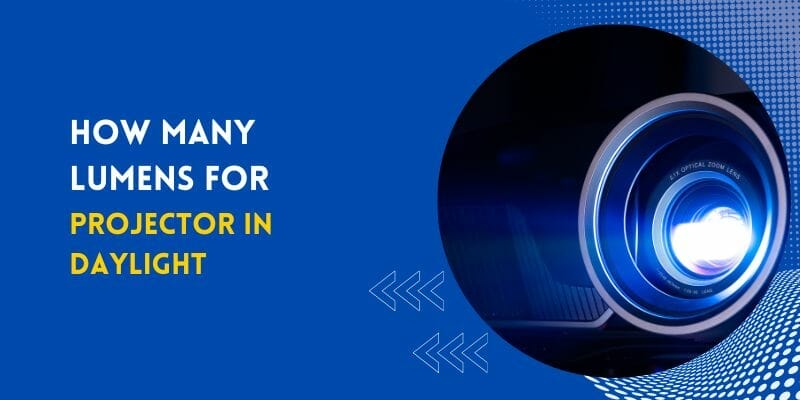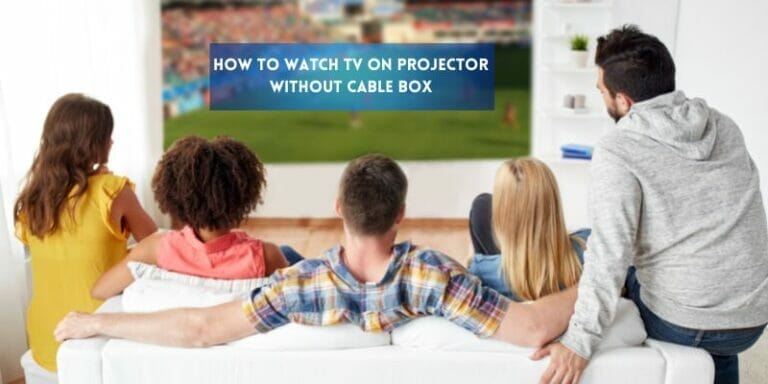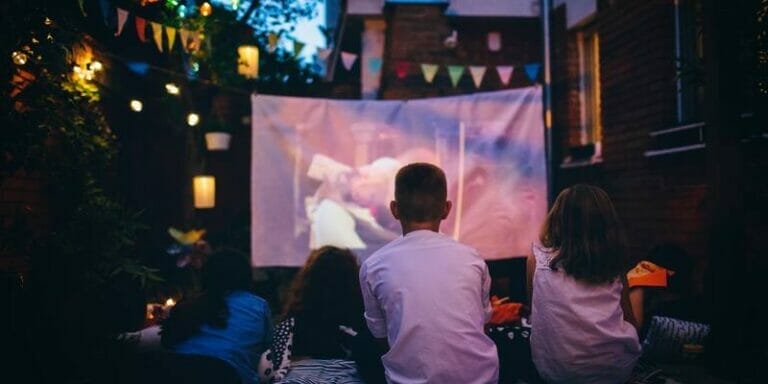How Many Lumens for Projector In Daylight
Projectors are relatively easy to use, but choosing the best one for your needs can be a little tricky. To find the balance between value and performance, you need to consider where and how your projector will be used.
There are some considerations that can help your projector project images, videos, or user interfaces in daylight.
Direct sunlight will make the projector’s own light faint, but general daylight and ambient light in any room can be handled with just the right amount of lumens for your projector of choice.
As a rule of thumb, a projector lamp brightness of at least 2,500 lumens or lux is required for proper projector image display in sunlight.
Most projectors instead follow the “3,000 lumens or more” rule, at least in particularly bright rooms. But 2,500 lumens is a good enough starting point.
How Many Lumens for Projector In Daylight
The bigger the number of lumens, the brighter the image. For example, the projector with 3000 lumens is a brighter projector than the one with 700 lumens.
The importance of brightness in daytime projection
Basically, the more lumens a projector lamp has, the brighter the resulting light.
The brighter the projector, the better it will look in ambient light, sunlight, open curtains, conference rooms, etc.
Low-light projectors require pitch-black or dim lighting and a reflective screen to ensure a clear image.

How bright is daylight?
Brightness in daylight or direct sunlight is 120,000 lux or lumens. However, if you’re projecting in your backyard for outdoor movie marathon action, etc., make sure the projector’s image is visible in daylight.
What is the difference between controlled light and daylight?
Daylight is not as controllable as certain other light sources such as lamps and ceiling lights. Ambient lighting in the meeting room can be turned off or dimmed as needed.
Daylight means finding shade, putting up an umbrella, using curtains, or installing a shed. This maximizes the brightness of the projector without losing intensity due to sunlight.
Therefore, avoid angles where the sun hits the screen directly. This results in a washed out image that is barely visible to the viewer. Be aware of glare and sunlight reflections.
Which brightness level best suits your needs?
A well-lit room requires higher brightness to provide a high-quality image. A dark room can use a combination of low brightness and high contrast ratio.
For home environments, you should choose a projector rated at less than 3000 ANSI lumens.
The ideal lumen range for multi-purpose rooms is 2000-4000 lumens.
Why Does the Projector Need to Be Bright?
Projectors are used to display images on large surfaces. When you use a projector, you want to have enough lumens so that the image is visible.
If you do not have enough lumens, your projector will not produce enough light to project the image. The amount of lumens in a projector also affects the size of the image. The bigger the image, the brighter the image. Therefore, you need to choose a projector with high lumens.
Is higher lumen projector better?
When it comes to screen size, the larger you want it, the higher the brightness recommended for the projector to deliver a quality image.
Highest lumen projector for outdoor use
There is no 120,000 lumen projector yet invented that can handle direct sunlight on a giant screen.
What you need is a little more shadows, a little more ALR screen action, or better placement to avoid projector images becoming virtually invisible or barely visible in sunlight.
So something like 5,500 lumens is more realistic and affordable if you are looking for the highest-lumen projector for your outdoor needs.
How many lumens for an outdoor projector?
When you want to enjoy entertainment on a big screen while camping or having a picnic outdoors with your family and friends, a portable mini projector is the most obvious choice.
A good portable projector is compact, lightweight, packed with smart features like Wi-Fi and Bluetooth connectivity, and offers at least 500 lumens.
With this type of lighting, portable projectors provide good display quality in most lighting conditions.
That’s why it’s important to have at least 500 lumens when choosing a portable projector for outdoor use.
Except for very bright cloudless days, portable projectors like this work well both at night and during the day.
What Are The Components Of A Good Projector?
A good projector will have these features:
- High-quality lenses
- High-quality bulbs
- Bright light
- Long life
- Good power supply
- Good control system
- Durable and long-lasting
Lamps
Lamps are essential for a projector. High-quality bulbs are necessary to achieve a bright image. Lamps with high-lumen output can produce a high-quality image. The brightness of a lamp determines the size of the image projected. The image quality will improve when the lumen output increases.
A higher lumen output means that you will get a brighter image. You will get a higher-quality image, too. High-quality lamps are used in many types of projectors.
Lumens is a unit that measures the amount of light produced by a lamp. It is measured in units of illumination and is usually expressed in lumens. One lumen equals one candlepower per square meter.
How Many Lumens for Outdoor Projectors?
Projectors are used in outdoor theaters as well. Most of these outdoor projectors are large, and they have larger screens than those used in indoor theaters.
In order to get the right quality of image, you need to know how many lumens you need for a projector. Atleast you need 3000 Lumens projector for outdoor movies.
The number of lumens needed for the projector depends on the screen size and the size of the image that you want to project. The larger the screen, the more lumens you will need.
How many lumens do I need to project video or present materials in broad daylight? You need more than just a few hundred lumens for that.
The most lumens projector wins even though the brightness of any projector is only one factor when making your decision. There are a number of other factors to consider, such as resolution, color, contrast, and more.
Resolution:
You need to consider the resolution of the images you are projecting. Resolution is the highest number of pixels in an image. Higher resolutions are more common with digital projectors. The number of pixels per inch (PPI) determines how clear the image will look. You can adjust the resolution of the images on your projector.
Color:
You need to know how the projector is designed. Some projectors are equipped with three separate screens. Each screen has a different color. Some projectors come with a single color screen. A single-color screen doesn’t provide color, but it is easier to see the images on the screen. It is up to you to decide which is better.
You also need to know what kind of lighting conditions you will be projecting the images in. The projector needs to be able to properly display the images under normal daylight conditions. In order to do that, you need to know the brightness of the light.

Contrast:
Contrast is another important factor when you are choosing a projector. The contrast ratio is a measurement of how light or dark your screen will appear. If you are watching movies and TV shows that are in black and white, you should select a projector with a higher contrast ratio.
A good projector has good contrast. Contrast is the difference between the lightest area of an image and the darkest area of an image. For example, the difference between black and white is 100 percent contrast. Contrast is measured in units called nits. One nit is equal to 1/100 of a lumen.
Brightness:
The brightness requirements can vary depending on the type of image. The image size can be very large, like a movie theater. You’ll need to determine how big the room is and how many people will be viewing the image at once.
If you use a projector to watch TV shows, movies, and videos, you will need at least 4,000 lumens of brightness to avoid blurry images. You may also need a projector that can project a resolution of 8K.
In case you are using it for business purposes, you will need at least 10,000 lumens. A projector with that much brightness can be used for presentations.
Dark Cinema Rooms:
Dark Cinema Rooms is an important topic to consider before selecting a projector. If you are looking to buy a new projection system or if you want to upgrade your existing system, you’ll need to determine what lumens of brightness are sufficient for the room in which you plan to view the image.

A Light-emitting Diode:
A LED projector requires less energy than a xenon projector, so you could save energy and money. It’s also possible to find a projector that’s more efficient for your intended use.
It’s important to look at brightness when buying a projector, which must be able to project a minimum of 1000 lumens in order for it to operate properly. The brightness requirements can vary widely depending on the type of image.
Conclusion
If you want to get the most out of your outdoor projector during the day, there are a few things you can do to ensure a great experience.
First, make sure the projector is positioned correctly. Bright light sources such as the sun should be avoided as they can affect vision.
Then use a screen or other reflective surface to deflect sunlight and improve contrast.
Finally, adjust the projector settings to match the lighting conditions. By following these tips, you can enjoy your outdoor projector even when the sun is shining!
Based on my analysis, the best projector which meets all the above requirements for a great daylight movie/gaming experience is the BenQ TK700STi 4K HDR Short Throw.
Promising 3000 lumens of high brightness, it’s perfect for viewing in a variety of environments.
Even when viewed outdoors, the images are stunning with eye-catching colors. Low 4K latency ensures unparalleled responsiveness when using this projector
For professional performance, this projector is compatible with a variety of consoles, from PS5, Sony PS4, and Nintendo Switch to Xbox. The projector also ensures excellent connectivity technology with Model Boosting Show Throw 100.
FAQs
How Many Lumens Is Good for a Projector in Daylight?
The projector requires a brightness of at least 2,500 lumens for proper image display in sunlight.
3000 lumens is a good starting point for shaded areas. But a 4000 or 5000-lumen outdoor projector is even better.
What Is the Difference Between Dlp and Lcd Projectors?
DLP projectors use a spinning mirror to reflect the light from the image, while LCD projectors use an LCD panel that uses liquid crystals to reflect the light. A DLP projector’s light source is typically more powerful than an LCD projector’s. The color spectrum of DLP projectors is greater than LCD projectors, but they do not have as much color accuracy.
Is 6500 Lumens Good for Outdoor Projectors?
Yes, a projector with a 6500-lumen output is good for outdoor use. But, If you’re buying a projector, it’s probably best to go with at least 3000 lumens. This will allow you to use the projector in a wide variety of lighting conditions and environments.
Are 7000 lumens good for a projector?
A 7000-lumen projector can’t compare to a standard 17,000-40,000 laser projector, but it’s bright enough for home, office, and school use.
Are 6000 lumens too bright?
6000 lumens is the optimal light output for LEDs and incandescent. Suitable for use with high-power lights, floodlights, and projectors, but can also be used with flashlights.
How many lumens is considered too bright?
In a completely dark room, ratings above about 2,000-2,500 lumens can appear overwhelmingly bright. However, when the projector is used in moderate to bright environments, none of the projectors on the consumer market are too bright to pose a danger to the eyes.
What are the suggested lumen counts for large settings?
The brightness level to consider is 5000+ ANSI lumens. Offering image sizes in excess of 100 inches, it is ideal for large conference rooms, exhibition halls, auditoriums, and more. The performance of these projectors means they perform well even in strong ambient light.







